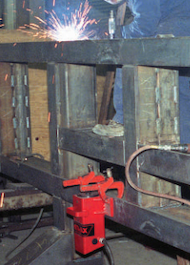Longeron
Description: Longerons for U.S. bombers, which connect the cockpit to the fuselage, consisted of forgings made out of 7075 aluminum and measured 8-inch x 18-inch x 18-feet. The finished product required several extensive machining steps. Forgings started at 1,665 lbs. and finished around 600 lbs. The tolerance over the length was 0.125-inch flatness.
Normal Performance: Normal distortion always exceeded the desired tolerance to the point that special approval was given to accept longerons with an overall flatness distortion that was less than 0.200-inch. Even with the special approval, the scrap rate was around 90 percent.
Performance After Meta-Lax Stress Relief: Meta-Lax stress relief was applied to one longeron (before any machining) as a trial. The Meta-Lax treated longeron was machined to an overall flatness of 0.087-inch (42% better than their previous best).






